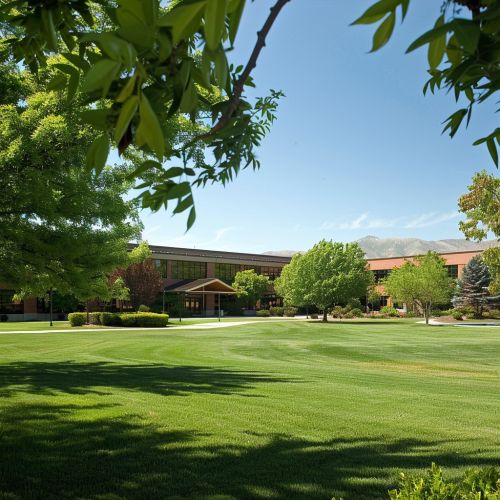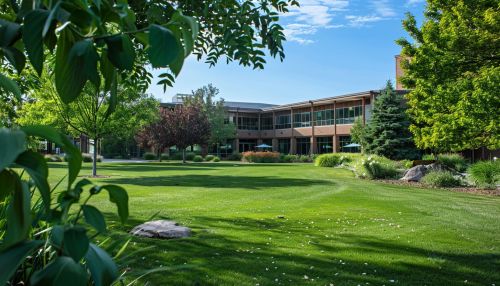Salt Lake Community College: Difference between revisions
(Created page with "== History == Salt Lake Community College (SLCC) was established in 1948 as the Salt Lake Area Vocational School. Initially, it was created to provide vocational training to returning World War II veterans. Over the years, the institution evolved, expanding its curriculum and facilities to meet the growing educational needs of the community. In 1959, it was renamed Salt Lake Trade Technical Institute, and in 1967, it became Utah Technical College at Salt Lake. The instit...") |
No edit summary |
||
| Line 8: | Line 8: | ||
The Taylorsville Redwood Campus is the main campus and administrative hub of SLCC. It houses the majority of the college's academic departments, administrative offices, and student services. The campus features state-of-the-art facilities, including the Markosian Library, the Lifetime Activities Center, and the Center for Arts and Media. | The Taylorsville Redwood Campus is the main campus and administrative hub of SLCC. It houses the majority of the college's academic departments, administrative offices, and student services. The campus features state-of-the-art facilities, including the Markosian Library, the Lifetime Activities Center, and the Center for Arts and Media. | ||
[[Image:Detail-93359.jpg|thumb|center|Salt Lake Community College Taylorsville Redwood Campus, showing the main building and surrounding greenery.|class=only_on_mobile]] | |||
[[Image:Detail-93360.jpg|thumb|center|Salt Lake Community College Taylorsville Redwood Campus, showing the main building and surrounding greenery.|class=only_on_desktop]] | |||
=== South City Campus === | === South City Campus === | ||
Latest revision as of 10:07, 22 June 2024
History
Salt Lake Community College (SLCC) was established in 1948 as the Salt Lake Area Vocational School. Initially, it was created to provide vocational training to returning World War II veterans. Over the years, the institution evolved, expanding its curriculum and facilities to meet the growing educational needs of the community. In 1959, it was renamed Salt Lake Trade Technical Institute, and in 1967, it became Utah Technical College at Salt Lake. The institution achieved its current name, Salt Lake Community College, in 1987, reflecting its broadened mission to offer a wide range of academic and vocational programs.
Campuses
SLCC operates multiple campuses throughout the Salt Lake Valley, each serving different academic and community needs. The primary campuses include:
Taylorsville Redwood Campus
The Taylorsville Redwood Campus is the main campus and administrative hub of SLCC. It houses the majority of the college's academic departments, administrative offices, and student services. The campus features state-of-the-art facilities, including the Markosian Library, the Lifetime Activities Center, and the Center for Arts and Media.


South City Campus
The South City Campus is located in downtown Salt Lake City and focuses on programs in the arts, communication, and media. It is home to the Center for Arts and Media, which includes television and radio studios, a film production facility, and various art studios.
Jordan Campus
The Jordan Campus is situated in the southwest part of the Salt Lake Valley and offers programs in health sciences, including nursing, dental hygiene, and emergency medical services. The campus features modern laboratories, simulation centers, and clinical facilities.
Miller Campus
The Miller Campus, located in Sandy, Utah, is dedicated to business and economic development. It includes the Miller Business Resource Center, which provides support for local entrepreneurs and small businesses, and the Corporate Partnership Center, which offers customized training programs for businesses.
Westpointe Campus
The Westpointe Campus focuses on technical and vocational training programs, including welding, machining, and automotive technology. It features advanced manufacturing labs and workshops designed to provide hands-on training for students.
Academic Programs
SLCC offers a diverse array of academic programs, including associate degrees, certificates, and diplomas. The college is organized into several schools and divisions, each specializing in different fields of study.
School of Arts, Communication, and Media
This school offers programs in visual arts, performing arts, communication, and media production. Students can pursue degrees in fields such as graphic design, film production, journalism, and music.
School of Business
The School of Business provides programs in accounting, finance, marketing, management, and entrepreneurship. It also offers specialized training in areas like hospitality management and real estate.
School of Health Sciences
The School of Health Sciences offers programs in nursing, dental hygiene, medical assisting, and other health-related fields. The school's facilities include simulation labs and clinical training centers to provide practical experience.
School of Science, Mathematics, and Engineering
This school offers programs in biology, chemistry, physics, mathematics, and engineering. Students can pursue degrees in fields such as biotechnology, environmental science, and computer science.
School of Technical Specialties
The School of Technical Specialties provides training in trades and technical fields, including automotive technology, welding, machining, and aviation maintenance. The programs are designed to meet industry standards and prepare students for immediate employment.
Student Life
SLCC offers a vibrant student life with numerous clubs, organizations, and activities. The college hosts events such as cultural festivals, guest lectures, and athletic competitions. Students can participate in various clubs, including academic, cultural, and recreational groups.
Athletics
SLCC's athletic teams, known as the Bruins, compete in the National Junior College Athletic Association (NJCAA). The college offers sports such as basketball, soccer, volleyball, and softball. The Lifetime Activities Center on the Taylorsville Redwood Campus serves as the primary athletic facility.
Student Government
The SLCC Student Association (SLCCSA) represents the student body and organizes events, activities, and advocacy efforts. The SLCCSA works to enhance the student experience and address student concerns.
Community Engagement
SLCC is deeply committed to community engagement and offers various programs and services to support the local community. The college provides continuing education, workforce training, and community education programs. Additionally, SLCC partners with local businesses, government agencies, and non-profit organizations to address community needs and promote economic development.
Notable Alumni
SLCC has a diverse and accomplished group of alumni who have made significant contributions in various fields. Notable alumni include:
- Gail Miller, businesswoman and philanthropist
- John Huntsman Jr., former Governor of Utah and U.S. Ambassador
- Stephen R. Covey, author and motivational speaker
See Also
- Community College
- Vocational Education
- Higher Education in the United States
- National Junior College Athletic Association
- Utah System of Higher Education
